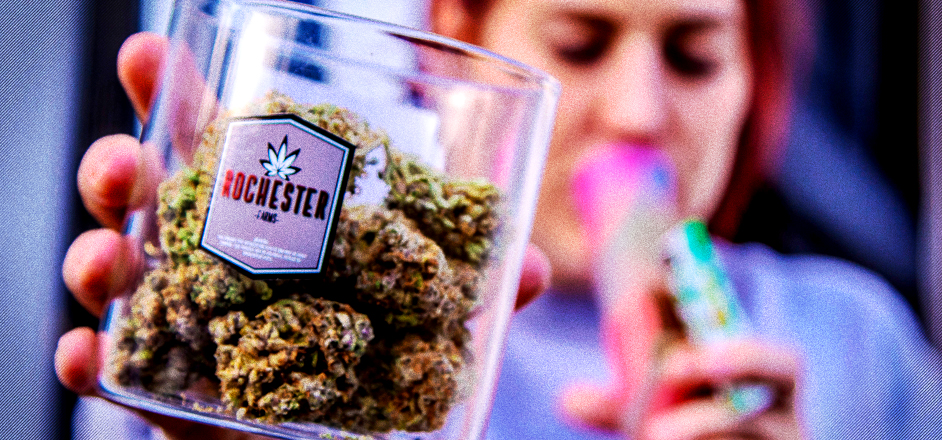Every intoxicant comes in many forms, each of which can get you different shades of fucked up. There’s alcohol: from drinking a beer to watch the game a little buzzed, to wine, for getting spurious at a dinner — and of course shots of hard liquor to get white-girl wasted, grind the night away, and then stumble home at 3:00 a.m. with no memory of the previous six hours.
The same is true of cannabis. There’s everything from a dirty block of low potency schwag rolled into a blunt the size of a baby’s arm to the scarily purified THC crystals of concentrates. As well as every shade of green in between.
And nowhere right now is the issue of weed strength more politicized than in the UK, where outspoken activists on the left and right argue about the difference between high-potency cannabis and your typical home-grown weed, straight out of the blissful, rosey-eyed past of the powers that be.
The debate started in 2008 when, in the UK, cannabis was changed from a Class C drug to a Class B — or the equivalent of a Schedule II drug in the U.S. This put it in the same category as speed.
As more and more people started to question this decision, several investigations emerged that pointed to a new threat in the age-old debate about the humble plant.
To strengthen its case, high-potency devil’s lettuce was labelled “skunk” by the UK government And this skunk was touted as a new type of cannabis, which the public could now be suitably scared of to justify its new rating. Now, every year, there is an increasing number of articles in the Rupert Murdoch-controlled UK press about widespread fears of a mental health epidemic of psychosis and schizophrenia, all directly caused by this supposed skunk cannabis.
The hysteria isn't without at least some merit, though. The flames have been fueled by compounding studies, like one from King’s College London, which claim that “Skunk-like” marijuana has been linked to 24 percent of new psychosis cases.
The other study often quoted by those against cannabis overseas, is one released by the UK Advisory Council in 2007, which concludes that those who were already diagnosed with schizophrenia might experience a worsening of their condition if they smoke weed — although the closest the study gets to giving definitive numbers is that "at worst, using cannabis increases the lifetime risk of developing schizophrenia by 1 per cent."
In the U.S, the recent wave of legalization — called for by Bob Marley so long ago — has ignited the same phony debate. Colorado University released a study suggesting that cannabis was “five times stronger” now than in the 1980s. However, to put these findings in perspective, the researcher of this study, professor Hopfer MD, is a long time cannabis skeptic, and has written several articles trying to accentuate the negative effects of cannabis, suggesting some bias.
Hopfer claims that in Colorado, dispensaries are selling marijuana with up to 25 percent THC, one the active intoxicating chemicals in weed. "It used to be 2-5 percent, so this stuff is potent," he says.
However, the reported 25 percent that dispensaries put on the label is when the plant is tested fresh, after just being cured. When it is sold in the dispensary, it’s gradually getting less potent over time. By the time it actually gets combusted by the consumer, the potency is inevitably significantly lower.
All that aside, one large recent study did have better evidence to suggest marijuana in the U.S is actually three times more potent than it was in 1995. This study analyzed 39,000 samples seized by the Drug Enforcement Administration in Mississippi in 2014, which found that the average potency was around 12 percent. Though even this exhaustive study didn’t note down the age of the samples, or how they had been stored, as this also affects potency. So, it only tells us so much.
Critics of these studies say that there has been no research into how cannabis users smoke their skunky-ass weed. Many suggest that, although cannabis enthusiasts are now smoking stronger strains of marijuana, they are also likely reducing their dose — as one such study finds — so that they get the same amount of high as people did in the past.
It’s natural to take smaller puffs when smoking really strong cough-inducing weed, proving sometimes it’s better to not believe the political propaganda surrounding pot. Especially when it ignores the reality of usage, and is designed to amplify an archaic reefer madness mentality.
So, it seems that as weed gets stronger, the number of joints consumed is getting smaller. New strains of weed are more potent, but users are getting the same level of fucked-up-ness as they always were. Just like it’s much easier to get drunk off whiskey, it’s easier to get blazed with modern forms of cannabis.
But we don’t ban hard alcohol, and we shouldn’t restrict weed because we have stronger forms of it.




Leave a Reply